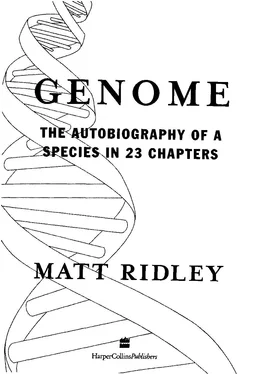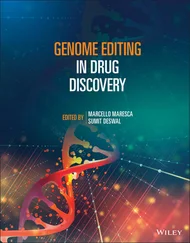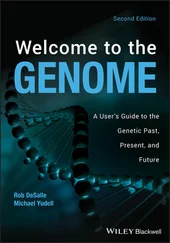Genome - Matt Ridley
Здесь есть возможность читать онлайн «Genome - Matt Ridley» весь текст электронной книги совершенно бесплатно (целиком полную версию без сокращений). В некоторых случаях можно слушать аудио, скачать через торрент в формате fb2 и присутствует краткое содержание. Жанр: Старинная литература, на английском языке. Описание произведения, (предисловие) а так же отзывы посетителей доступны на портале библиотеки ЛибКат.
- Название:Matt Ridley
- Автор:
- Жанр:
- Год:неизвестен
- ISBN:нет данных
- Рейтинг книги:5 / 5. Голосов: 1
-
Избранное:Добавить в избранное
- Отзывы:
-
Ваша оценка:
- 100
- 1
- 2
- 3
- 4
- 5
Matt Ridley: краткое содержание, описание и аннотация
Предлагаем к чтению аннотацию, описание, краткое содержание или предисловие (зависит от того, что написал сам автор книги «Matt Ridley»). Если вы не нашли необходимую информацию о книге — напишите в комментариях, мы постараемся отыскать её.
Matt Ridley — читать онлайн бесплатно полную книгу (весь текст) целиком
Ниже представлен текст книги, разбитый по страницам. Система сохранения места последней прочитанной страницы, позволяет с удобством читать онлайн бесплатно книгу «Matt Ridley», без необходимости каждый раз заново искать на чём Вы остановились. Поставьте закладку, и сможете в любой момент перейти на страницу, на которой закончили чтение.
Интервал:
Закладка:
None of this is yet possible - human ES cells have only just been found — but it is very unlikely to remain impossible for much longer. When human cloning is possible, will it be ethical? As a free individual, you own your own genome and no government can nationalise it, nor company purchase it, but does that give you the right to inflict it on another individual? (A clone is another individual.) Or to tamper with it? For the moment society seems keen to bind itself against such temptations, to place a moratorium on cloning or germline gene therapy and strict limits on embryonic research, to forego the medical possibilities in exchange for not risking the horrors of the unknown. We have drummed into our skulls with every science fiction film the Faustian sermon that to tamper with nature is to invite diabolic revenge. We have grown cautious. Or at least we have as voters. As consumers, we may well act differently. Cloning may well happen not because the majority approves, but because the minority acts. That, after all, was roughly what happened in the case of test-tube babies. Society never decided C U R E S 257
to allow them; it just got used to the idea that those who desperately wanted such babies were able to have them.
Meanwhile, in one of those ironies which modern biology supplies in abundance, if you have a faulty tumour-suppressor gene on chromosome 18, forget gene therapy. A much simpler preventive treatment may be at hand. New research suggests that for those with genes that increase their susceptibility to bowel cancer, a diet rich in aspirin and unripe bananas offers the promise of protection against the cancer. The diagnosis is genetic, but the cure is not.
Genetic diagnosis followed by conventional cure is probably the genome's greatest boon to medicine.
C H R O M O S O M E 1 9
P r e v e n t i o n
Ninety-nine per cent of people don't have an inkling about how fast this revolution is coming.
Steve Fodor, president of Asymetrix
The improvement of any medical technology confronts our species with a moral dilemma. If the technology can save lives, then not to develop it and use it is morally culpable, even if there are attendant risks. In the Stone Age, we had no option but to watch our relatives die of smallpox. After Jenner had perfected vaccination we were derelict in our duty if we did so. In the nineteenth century, we had no alternative to watching our parents succumb to tuberculosis.
After Fleming found penicillin we were guilty of neglect if we failed to take a dying tubercular patient to the doctor. And what applies on the individual level applies with even greater force on the level of countries and peoples. Rich countries can no longer ignore the epidemics of diarrhoea that claim the lives of countless children in poor countries, because no longer can we argue that nothing medically can be done. Oral rehydration therapy has given us a conscience.
Because something can be done, so something must be done.
P R E V E N T I O N 2 5 9
This chapter is about the genetic diagnosis of two of the commonest diseases that afflict people, one a swift and merciless killer, the other a slow and relentless thief of memory: coronary heart disease and Alzheimer's disease. I believe we are in danger of being too squeamish and too cautious in using knowledge about the genes that influence both diseases, and we therefore stand at risk of committing the moral error of denying people access to life-saving research.
There is a family of genes called the apolipoprotein genes, or APO
genes. They come in four basic varieties, called A, B, C and - strangely
- E, though there are various different versions of each on different chromosomes. The one that interests us most is APOE, which happens to lie here on chromosome 19. To understand APOE's job requires a digression into the habits of cholesterol and triglyceride fats. When you eat a plate of bacon and eggs, you absorb much fat and with it cholesterol, the fat-soluble molecule from which so many hormones are made (see the chapter on chromosome 10). The liver digests this stuff and feeds it into the bloodstream for delivery to other tissues. Being insoluble in water, both triglyceride fats and cholesterol have to be carried through the blood by proteins called lipoproteins. At the beginning of the journey, laden with both cholesterol and fats, the delivery truck is called V L D L , for very-low-density lipoprotein. As it drops off some of its triglycerides, it becomes low-density lipoprotein, or L D L ('bad cholesterol').
Finally, after delivering its cholesterol, it becomes high-density lipoprotein, H D L ('good cholesterol') and returns to the liver for a new consignment.
The job of APOE's protein (called apo-epsilon) is to effect an introduction between V L D L and a receptor on a cell that needs some triglycerides; APOB's job (or rather apo-beta's) is to do the same for the cholesterol drop-off. It is easy to see therefore that APOE and APOB are prime candidates for involvement in heart disease. If they are not working, the cholesterol and fat stay in the bloodstream and can build up on the walls of arteries as atherosclerosis. Knockout mice with no APOE genes get atherosclerosis even 2 6 0 G E N O M E
on a normal mouse diet. The genes for the lipoproteins themselves and for the receptors on cells can also affect the way in which cholesterol and fat behave in the blood and thereby facilitate heart attacks. An inherited predisposition to heart disease, called familial hypercholesterolaemia, results from a rare 'spelling change' in the gene for cholesterol receptors.1
What marks APOE out as special is that it is so 'polymorphic'.
Instead of us all having one version of the gene, with rare exceptions, APOE is like eye colour: it comes in three common kinds, known as E2, E3 and E4. Because these three vary in their efficiency at removing triglycerides from the blood, they also vary in their susceptibility to heart disease. In Europe, E3 is both the 'best' and the commonest kind: more than eighty per cent of people have at least one copy of E3 and thirty-nine per cent have two copies. But the seven per cent of people who have two copies of E4 are at markedly high risk of early heart disease, and so, in a slightly different way, are the four per cent of people who have two copies of E2.2
But that is a Europe-wide average. Like many such polymorphisms, this one shows geographical trends. The further north in Europe you go, the commoner E4 becomes, at the expense of E3
(E2 remains roughly constant). In Sweden and Finland the frequency of E4 is nearly three times as high as in Italy. So, approximately, is the frequency of coronary heart disease.3 Further afield, there are even greater variations. Roughly thirty per cent of Europeans have at least one copy of E4; Orientals have the lowest frequency at roughly fifteen per cent; American blacks, Africans and Polynesians, over forty per cent; and New Guineans, more than fifty per cent.
This probably reflects in part the amount of fat and fatty meat in the diet during the last few millennia. It has been known for some while that New Guineans have little heart disease when they eat their traditional diet of sugar cane, taro and occasional meals of lean bush meat from possums and tree kangaroos. But as soon as they get jobs at strip mines and start eating western hamburgers and chips, their risk of early heart attacks shoots up - much more quickly than in most Europeans.4
P R E V E N T I O N 2 6 1
Heart disease is a preventable and treatable condition. Those with the E2 gene in particular are acutely sensitive to fatty and cholesterol-rich diets, or to put it another way, they are easily treated by being warned off such diets. This is extremely valuable genetic knowledge. How many lives could be saved, and early heart attacks averted, by simple genetic diagnosis to identify those at risk and target treatment at them?
Читать дальшеИнтервал:
Закладка:
Похожие книги на «Matt Ridley»
Представляем Вашему вниманию похожие книги на «Matt Ridley» списком для выбора. Мы отобрали схожую по названию и смыслу литературу в надежде предоставить читателям больше вариантов отыскать новые, интересные, ещё непрочитанные произведения.
Обсуждение, отзывы о книге «Matt Ridley» и просто собственные мнения читателей. Оставьте ваши комментарии, напишите, что Вы думаете о произведении, его смысле или главных героях. Укажите что конкретно понравилось, а что нет, и почему Вы так считаете.












